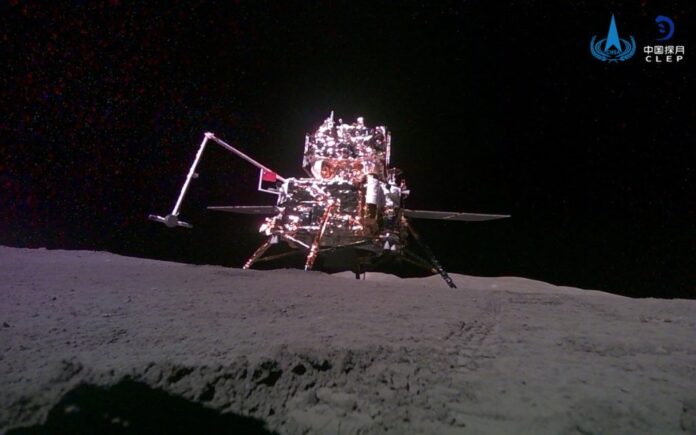For decades, the far side of the Moon has remained a blank spot on our scientific map. Unlike the familiar face that always looks back at Earth, the Moon’s far side is rougher, older, and far less studied. But that’s beginning to change.

On 25 June, China’s Chang’e‑6 mission returned safely to Earth, landing in Inner Mongolia. On board: a groundbreaking payload — the first-ever physical samples from the far side of the Moon. And already, these rocks and soil are telling a story no one expected.
Unpacking the Moon’s hidden history
The Chang’e‑6 lander collected 1.935 kilograms of lunar material from the South Pole–Aitken (SPA) Basin, the largest and oldest impact structure on the Moon. Scientists believe this enormous crater formed approximately 4.25 billion years ago, providing a direct glimpse into the Moon’s earliest history.

Samples were taken from the rim of the Apollo Basin, a site within the larger SPA region. This location was chosen precisely because it may expose material from deep within the crust, and possibly the upper mantle.
Volcanoes and magnetic echoes
What researchers found surprised them. The collected samples suggest that the far side experienced two distinct volcanic periods — one approximately 4.2 billion years ago and a second around 2.8 billion years ago. That second wave of activity stretches the known timeline for volcanism on the far side by over a billion years.
Even more surprisingly, traces in the younger rocks point to a brief revival of the Moon’s magnetic field. Until now, scientists believed the Moon’s internal dynamo had long shut down. However, these findings suggest that the Moon may have remained geologically active much later than previously thought.
A dry and depleted lunar interior
One of the most striking discoveries lies in the field of chemistry. Compared to samples returned by Apollo missions, Chang’e‑6 material contains very little water, only 1 to 1.5 micrograms per gram. In contrast, rocks from the Moon’s near side hold up to 200 micrograms per gram.

This suggests that the far side’s mantle is not only drier but also more chemically depleted. That may explain why it has fewer volcanic plains and appears less geologically “refreshed” than the near side. Scientists are now asking whether this contrast dates back to the Moon’s formation or evolved over time.
Why it matters
For years, researchers have puzzled over the Moon’s two very different faces. One is smooth and dark, dominated by lava plains. The other is rugged, cratered, and ancient. Theories about this contrast have remained speculative — until now.
Thanks to Chang’e‑6, we now have complex data. These findings indicate that the Moon’s far side followed a distinctly different evolutionary path, shaped by distinct thermal, volcanic, and magnetic conditions. This doesn’t just reshape lunar science — it challenges how we think about rocky planets in general.
What comes next
The early results, published in Nature, are just the beginning. Over the coming months, China’s Institute of Geology and Geophysics (IGG) will distribute portions of the samples to domestic and international teams. These groups will carry out isotopic dating, high-resolution mineral analysis, and deep-model simulations of the Moon’s internal evolution.

Meanwhile, China is already looking ahead. The upcoming Chang’e‑7 mission, set to launch in 2026, will explore the Moon’s south pole, including areas that remain in permanent shadow. These regions could hold water ice, a vital resource for future missions.
Conclusion
The Moon’s far side is no longer a mystery hidden from view. Thanks to Chang’e‑6, it’s becoming one of the richest sources of insight into the early Solar System.

